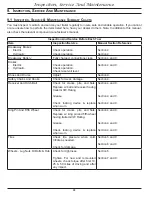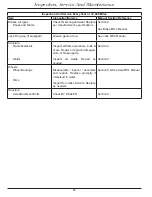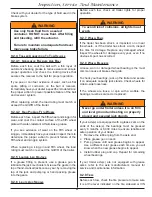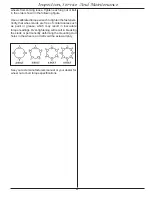
34
In addition to tow vehicle control, tongue weight is
necessary to insure that the trailer axle(s) do not
exceed their Gross Axle Weight Rating (GAWR).
The rule of thumb is that 20-25% percentage of total
weight of the trailer plus its cargo (Gross Trailer Weight,
or “GTW”) that should be on the tongue of the trailer.
For example, a gooseneck trailer with a loaded weight
of 6,000 pounds, should have 20-25% of 6,000 pounds
(1200-1500 lbs.) on the hitch.
The numbers quoted are for example purposes only
and should be tailored to the specific trailer.
For questions regarding the actual percent of tongue
weight for the trailer, check with the manufacturer
for specifics.
^
WARNING
Improper tongue weight (load distribution)
can result in loss of control of the trailer,
leading to death or serious injury.
Make certain that tongue weight is within
the allowable range.
Be sure to:
• Distribute the load evenly, right and left.
• Keep the center of gravity low.
• Distribute the load front-to-rear to provide
proper tongue weight.
A flowable load must be evenly distributed
throughout the body.
4.4.1 c
heckIng
t
ongue
w
eIght
To check the tongue weight, the tow vehicle and trailer
must be on level ground, as they will be when the trailer
is being towed.
Take the trailer to a truck stop or grain elevator where
there is a “certified” scale. Place the tow vehicle only
onto the scale and get the weight. This weight must be
less than your tow vehicle’s GVWR.
Pull the trailer onto the scale and uncouple it from the
tow vehicle, leaving just the trailer on the scale. Get a
ticket which lists the total trailer weight. Re-connect the
trailer to your tow vehicle and the drive the tow vehicle
wheels off the scale, just leaving the trailer axles on the
scale. Get a “ticket”, which lists the trailer’s axle weight.
Simply subtract the axle weight from the total weight to
determine the hitch weight.
While you are at the scale, you should weigh the entire
combination vehicle. This result should be less than
the Gross Combined Weight Rating (GCWR) for your
towing vehicle. Some scales allow you to get individual
axle weights also. If this is possible, get the tow vehicles
front and rear axle weights to make sure they are in the
same proportion as the tow vehicle alone, and that the
rear axle is not overloaded.
4.5 a
djuSt
g
ooSeneck
h
eIght
The height of the receiver or king pin on the trailer must
be adjusted so that the trailer, when loaded to rated
capacity, is level while connected to the tow vehicle.
A level trailer allows equal weight distribution on the
axles.
Your dealer or a trailer service center can perform this
adjustment or you can use the following steps to adjust
the hitch height yourself.
^
WARNING
Improper receiver or king pin height
adjustment can result in overloaded tires,
blowout and loss of control, leading to
death or serious injury.
Adjust the receiver or king pin height so
that the loaded trailer is level.
1.
Connect trailer to tow vehicle and load the trailer to
rated capacity. See Loading And Unloading.
2.
Park the tow vehicle and trailer on a firm level
surface.
3.
Stand away from the trailer and visually verify if the
trailer is level front-to-rear. If the front of the trailer
is higher than the rear, the hitch must be raised.
If the front of the trailer is lower than the rear, the
hitch must be lowered.
4.
Uncouple trailer from tow vehicle.
5.
Loosen jam nuts and set screws (A).
6.
Remove retaining pin (B) and load bearing pin (C)
if equipped.
7.
Extend or retract the receiver or king pin as needed
up to the maximum specified by the manufacturer.
8.
If equipped, fully insert load bearing pin (B)
through one set of holes in coupler and outer tube.
Coupling To Tow Vehicle
Содержание Gooseneck SERIES
Страница 13: ... 13 2 2 17 Safety Warning Labels On Your Trailer Safety ...
Страница 50: ... 50 ...
Страница 51: ... 51 ...
Страница 52: ... 52 ...
















































